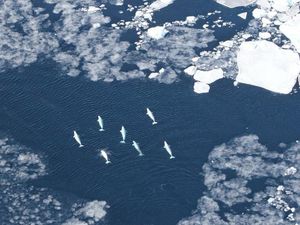Narwhals most at risk from newly opened Arctic shipping routes
Scientists identify sea mammals threatened by shipping traffic in regions previously blocked by ice.

Narwhals top the list of sea mammals most at risk from ships ploughing through previously ice-bound regions of the Arctic, say scientists.
The charismatic whales, famous for their distinctive long tusks, are highly sensitive to any kind of disturbance and live “smack dab” in the middle of the the newly opened shipping routes.
Other mammals found to be vulnerable to the rise in shipping traffic, brought about by climate change, include beluga and bowhead whales and walruses.
In August 2016, the first large cruise ship travelled through the Northwest Passage, the Arctic waterway linking the Atlantic and Pacific oceans.
A year later the first ship without an icebreaker plied the Northern Sea Route, a path along Russia’s Arctic coast that was until recently impassable for unescorted commercial vessels.
Now a new study has identified the risk faced by sea mammals living in or near the shipping routes in September, when the Arctic Ocean has the most open water.
US lead researcher Dr Donna Hauser, from the University of Alaska Fairbanks, said: “We know from more temperate regions that vessels and whales don’t always mix well, and yet vessels are poised to expand into this sensitive region.
“Even going right over the North Pole may be passable within a matter of decades. It raises questions of how to allow economic development while also protecting Arctic marine species.”
The study found that 42 out of 80 sub-populations of seven marine mammals were likely to be exposed to Arctic shipping traffic.
The most vulnerable were narwhals, which migrate through parts of the Northwest Passage to and from their summer time habitats.
Co-author Dr Kristin Laidre, from the University of Washington, US, said: “Narwhals have all the traits that make them vulnerable to vessel disturbances – they stick to really specific areas, they’re pretty inflexible in where they spend the summer, they live in only about a quarter of the Arctic, and they’re smack dab in the middle of shipping routes.
“They also rely on sound, and are notoriously skittish and sensitive to any kind of disturbance.”
The least vulnerable animals were polar bears, which largely stay on land in September and do not rely on underwater sound for communication or navigation.
The study, published in the journal Proceedings of the National Academy of Sciences, identified two “pinch points” – narrow passages were ships and animals were most likely to intersect.
One was the Bering Strait separating the US and Russia and the other was Lancaster Sound in the northern Canadian territory of Nunavut. At these spots, the risk of conflict was two to three times higher than in other shipping route areas.
Between 2011 and 2016 more than 200 ships passed through the Northern Sea Route and more than 100 travelled through the Northwest Passage, said the scientists.
More than half were small private vessels, such as personal yachts.





